Results 6,721 to 6,730 of 12094
Thread: Anandtech News
-
02-11-17, 02:21 PM #6721
Anandtech: NVIDIA Releases Android 7.0 Update for SHIELD Tablet
A couple of weeks back NVIDA released their Android 7.0 “Nougat” update for their original SHIELD TV. Now this week their other SHIELD devices are getting in on the action, with the release of the Android 7.0 update for the SHIELD Tablet and its Tablet K1 sibling.
Android 7.0 brings a few major changes to tablets, particularly the implementation of split-screen application mode for improved multitasking. But arguably what makes this update so noteworthy is that Android 7.0 updates for tablets have been few and far between, making this one of the few tablets to get the update so far. Other than Google’s most recent tablets such as the Pixel C and Nexus 9, and Sony’s Xperia X4 tablet, very few vendors have released updates for their tablets. Which, unfortunately, isn’t too surprising given that Android tablet sales outside of the “portable TV” segment have taken a beating.
In the SHIELD Tablet’s case things are especially interesting since this is quite likely the only Cortex-A15 powered tablet that will ever receive Google’s latest OS. This itself is something of an artifact of NVIDIA’s product strategy – the company still sells the refreshed SHIELD Tablet K1 to this day – but I have to give NVIDIA credit where it’s due since it means they’ve kept their promise to offer long-term update support for the Tablet and other SHIELD devices. Coming upon its 3rd birthday I suspect the tablet never got quite as much traction or consumer recognition as NVIDIA was hoping for, but NVIDIA’s carved out an interesting niche in a rough market by offering a mid-sized (8-inch) tablet with extended support.
In any case, the Android 7.0 update brings with it the typical slew of feature updates expected with Nougat, including the earlier mentioned multitasking features, notification changes, and the operating system’s new and better-performing JIT compiler. Along with Google’s feature changes, on the NVIDIA side of matters the update also adds support for the 2017 SHIELD peripherals, should any Tablet owners still need a(nother) SHEILD Controller.
The full patch notes are available below. The update is available now for the SHIELD Tablet and SHIELD Tablet K1, while the LTE version of the original tablet is reportedly still waiting on carrier approval.
- New Multitasking Features
- Split-screen: Run two apps side by side* in Portrait or Landscape modes
- Quick switch: Double tap the Overview button to quickly switch back to the last opened app
- SHIELD Controller (2017) Support
- Updates to SHIELD controller support
- SHIELD Rewards Program
- Introducing SHIELD Rewards, the exclusive loyalty program for SHIELD owners
- Improved Notifications
- Multiple notifications from the same app are now bundled for a streamlined experience
- Reply to messages directly from within the notification*
- Tap and hold on a notification to quickly silence or block notifications from the app
- Improved Power Consumption
- Doze on the Go: Doze is now smarter & kicks in even when the device is being carried around
- Emoji
- Includes all-new Unicode 9 emojis
- Usability Improvements
- Display & Font size can now separately adjustable to improve redability or screenspace
- Quick Settings can now be customized directly from the menu by tapping “Edit”
- The top Quick Setting tiles can now be accessed with a downward swipe from the lock screen
- Settings now includes a Navigation Menu & Suggestions to improve usability
- The “Clear all” option in Overview have been relocated to the top right
- System wide improvements including
- Updates to SHIELD controller support
- New Data Saver: when enabled, limits access to Cellular data for background apps
- New JIT complier: improves the speed of App & System updates
- Update to Android Security Patch Level December 1, 2016
More...
- New Multitasking Features
-
02-13-17, 07:03 AM #6722
Anandtech: Qualcomm Announces 802.11ax Access Point and Client Solutions
Wi-Fi platforms have traditionally focused on peak speeds. However, evolving usage scenarios (such as stadium and campus environments and even households with multiple Wi-Fi devices) have led to the appearance of standards aimed at solving the 'capacity' problem. We saw 802.11ac Wave 2 devices come to the market over the last couple of years. MU-MIMO on the downlink side was one of the first features to address this capacity issue.
802.11ax is set to become the next major leap in Wi-Fi technology. The last major introduction (802.11ac) has since been complemented by 802.11ad in the 60 GHz band, but, 802.11ax is the technology that will provide performance benefits in the 2.4 GHz and 5 GHz bands. Quantenna was the first to announce a draft-802.11ax-compliant access point radio solution back in October 2016. It was a 12-stream solution with 8x8 in the 5 GHz band and 4x4 in the 2.4 GHz band. They followed it up with a CES 2017 announcement for their mid-range solution (8-stream with 4x4 in the 5 GHz and 4x4 in the 2.4 GHz bands) targeting the same market. Today, Qualcomm has become the second vendor to announce a 802.11ax solution. Unlike Quantenna's focus on the access point side, Qualcomm is announcing products for both the AP and client device markets.
IPQ8074
Similar to the Quantenna QSR10G-AX, the IPQ8074 is also a 12-stream solution (8x8 5GHz + 4x4 2.4GHz). However, in addition to the baseband, it also integrates a network processor. On the baseband side, the IPQ8074 supports 80 MHz channel width and has MU-MIMO for both uplink and downlink. In addition to the baseband radios, the IPQ8074 also integrates a quad-core Cortex-A53 (running at up to 2 GHz) and a dual-core network accelerator for deep packet inspection and other such applications. interfaces similar to the existing IPQ solutions (for USB and PCIe lanes) are supported. On the network side, a network switch with support for up to four Gigabit MACs is also available. The IPQ8074 SoC also supports NBASE-T, with up to two 10G interfaces supported. The SoC is fabricated in a 14nm processor. Qualcomm expects that access points using the IPQ8074 SoC can be powered via PoE.
QCA6290
The QCA6290 client device platform is a 2x2 802.11ax solution with concurrent dual-band operation. IIt is fabricated in a 28nm process. The platform supports the 802.11ax power saving features along with some proprietary Qualcomm extensions for better battery life. Qualcomm expects the QCA6290 to be integrated into computing systems rather than being a part of a USB WLAN adapter. The QCA6920 interfaces with the host system via a PCIe 2.1 x1 link. Qualcomm didn't provide us with concrete power consumption limits (such as the 15W PoE budget for systems based on the IPQ8074) for cards integrating the platform.
Qualcomm claims that their proven MU-MIMO leadership experience as well as their expertise with OFDMA / LTE (based on their cellular background) gives them a edge when it comes to 802.11ax solutions. Note that existing networks with 802.11ac MU-MIMO devices can also benefit in a 802.11ax network.
Traditionally, Qualcomm's main competition in the Wi-Fi space has been Broadcom. However, since the acquisition by Avago, things have been relatively quiet and no 802.11ax solutions have been publicly announced by them. Marvell does have 802.11ax solutions in their roadmap, though they weren't willing to discuss specifics when I talked to them at CES 2017. In any case, Marvell's focus has been more on the enterprise space. The main competition (based on announcements from other vendors) is Quantenna's radio-only solutions. Based on the quotes in Quantenna's launch release, it appears that they are teaming up with Cavium Networks for the network processor component. This works well in the enterprise space and for specific service provider use-cases. However, most market segments prefer the complete platform (radios and network processor) from one vendor. The platform might be either discrete radios and NPUs or a SoC with integrated radios like the IPQ8074 being launched today. The integration of the radios and NPU into a single chip will definitely make it simpler for router / gateway vendors to bring a product into the market. Another aspect to consider is the unified memory space offered to both the baseband and the network processor in the case of the integrated SoC - as the PHY rates from the radio move beyond the gigabit barrier, this becomes important for the performance and energy efficiency of the system.
From an adoption perspective, it is good to see that both AP and client platforms being launched simultaneously. Qualcomm expects routers based on the IPQ8074 SoC to come to the market before the end of the year. Client devices using the QCA6290 are expected in 2018.
More...
-
02-13-17, 08:18 AM #6723
Anandtech: Intel Announces the Xeon E7-8894 v4 CPU: 24 Cores at 2.4 GHz for $8898
In the past week, Intel has launched a new halo CPU - its highest-performing multi-core CPU for multi-socket mission-critical servers, the Xeon E7-8894 v4. The new processor is based on the Broadwell-EX die and has approximately a 200 MHz higher base frequency than its direct predecessor, released in Q2 2016. Intel said that the new CPU has set a number of records in various benchmarks. Intel’s customers interested in the chip will also have to pay a record price too.
The flagship Intel Xeon E7-8894 v4 processor features the Broadwell-EX XCC (extreme core-count) die and has 24 cores with Hyper-Threading technology, 60 MB of L3 cache, 165 W TDP, a default frequency of 2.4 GHz and a turbo frequency of up to 3.4 GHz. Like other Broadwell-EX XCC CPUs, the new chip has quad-channel DDR3/DDR4 memory controller support and can manage up to ~3 TB of DRAM per socket (when used in conjunction with four Jordan Creek 2 scalable memory buffers). The CPUs are also equipped with 32 PCIe 3.0 lanes and three 9.6 GT/s QPI links for multi-socket environments.
Intel’s multi-core Xeon E7 processors are designed for various heavy-duty servers with four, eight or more sockets (to support more than eight sockets special third-party node controllers are required). Such mission-critical machines typically to be available 24/7/365 and this is why the Xeon E7 v4 and the Broadwell-EX range has a host of various RAS (reliability, availability, serviceability) features. The Xeon E7-8894 v4 CPU has exactly the same set of capabilities as its direct predecessor, the Xeon E7-8890 v4 released last year.Intel E7-8800 v4 Xeon Family E7-8867 v4 E7-8870 v4 E7-8880 v4 E7-8890 v4 E7-8894
v4E7-8891 v4 E7-8893 v4 TDP 165 W 140 W 150 W 165 W 165 W 140 W Cores 18 / 36 20 / 40 22 / 44 24 / 48 10 / 20 4 / 8 Base Freq 2400 2100 2200 2200 2400 2800 3200 Turbo 3300 3000 3300 3400 3500 3500 L3 Cache 45 MB 50 MB 55 MB 60 MB 60 MB 60 MB QPI (GT/s) 3 × 9.6 3 x 9.6 3 x 9.6 DRAM DDR4-1866
DDR3-1600DDR4-1866
DDR3-1600PCIe PCIe 3.0 x32 3.0 x32 3.0 x32 Price $4672 $4762 $5895 $7174 $8898 $6841 $6841
Intel claims that due to increased default frequency (and obviously because of the core count in general), the Xeon E7-8894 v4 sets a number of performance records in various general, server, HPC, big data analytics, business processing, database and other benchmarks, such as SPECint_base2006, SPECompG_2012, and so on.
The Intel Xeon E7-8894 v4 processor carries a tray price of $8898, which is the highest price of an Intel mass-produced CPU ever. Its predecessor on the top spot in the range, the 24-core Xeon E7-8890 v4 (which runs at 2.2 GHz) is priced at $7174 and still sits at its original tray price. As always, there are customers willing to pay such sums of money for server CPUs that deliver certain levels of performance. Moreover, there are workloads that benefit from a +200MHz (9%) performance increase so significantly (from a financial point of view to the owners of the machines) that it justifies paying extra 24% (or $1724) for a 200 MHz frequency increase (provided that this is the only advantage that this CPU has over the E7-8890 v4).
*Intel also has the E3-1500M v5 and E3-1500M v6 mobile parts which are left out of this tableIntel Xeon E-Series Families (February 2017)* E3-1200 v5 E3-1500 v5 E5-1600 v4
E5-2600 v4
E5-4600 v4E7-4800 v4 E7-8800 v4 Core Family Skylake Skylake Broadwell Broadwell Broadwell Core Count 2 to 4 2 to 4 4 to 22 8 to 16 4 to 24 Integrated Graphics Few, HD 520 Yes, Iris Pro No No No DRAM Channels 2 2 4 4 4 Max DRAM Support (per CPU) 64 GB 64 GB 1536 GB 3072 GB 3072GB DMI/QPI DMI 3.0 DMI 3.0 2600: 1xQPI
4600: 1xQPI3 QPI 3 QPI Multi-Socket Support No No 2600: 1S/2S
4600: 1S/2S1S, 2S or 4S Up to 8S PCIe Lanes 16 16 40 32 32 Cost $213 to
$612$396 to
$1207$294 to
$7007$1223 to
$3003$4061 to
$8898Suited For Entry Workstations QuickSync,
Memory ComputeHigh-End Workstation Many-Core Server World Domination
We've asked Intel to disclose the official per-core turbo numbers for comparison to their other chips, as well as a full range of DRAM support depending on memory type and memory density. We will update this news piece as we get more information.
Related Reading:
- Intel Launches 4S and 8S Broadwell-EX Xeons: E7-4800 v4 and E7-8800 v4 Families, up to 384 Threads
- The Intel Xeon E5 v4 Review: Testing Broadwell-EP With Demanding Server Workloads
- Broadwell E3 v4 Xeons: Cirrascale at SuperComputing 15
More...
-
02-14-17, 02:56 AM #6724
Anandtech: AMD Releases Radeon Software Crimson ReLive Edition 17.2.1
Despite the arrival of Valentine’s day, gamers are still gonna game, and AMD is in to prepare us for this week’s game releases. The new update for Radeon Software Crimson ReLive Edition 17.2.1 comes with display driver version 16.60.2011 (Windows Driver Store Version 21.19.519.0), and brings with it a collection of fixes and optomizations.
In this update AMD has rolled out several bug fixes. Starting things off, we first have a fix for For Honor where users were experiencing an application crash when switching to full screen or menus from gameplay on Multi GPU setups. Also fixed is an issue with Radeon GCN products where DXVA H.264 encoded video could experience corruption when seeking through content. Speaking of GCN, Radeon HD 7900 series products have a fix in for shadow corruption in Civilization VI. And Counterstrike: Global Offensive had incorrect default slider values with Radeon Chill Enabled.
Meanwhile Radeon ReLive recording has a few fixes. GPU information was missing from the system information overlay on ReLive captured videos, but has now been found, and ReLive recording in full screen with Windows Media Player of Power DVD should no longer experience flickering. Also, DayZ had a chance of crashing when Radeon ReLive Instant Replay/Recording was active. Lastly, we had memory clocks on R9 380 products locked at low states fixed and a fix for GRID Autosport users experiencing an application hang when advanced lighting was enabled.
Finally, this update brings official support for For Honor, the latest Valentine’s day blockbuster. AMD claims that, compared to ReLive edition 17.1.2 we’ll see up to a 4% performance improvement with this driver update. Sniper Elite 4 is the other Valentine’s day blockbuster (I guess kids these days would rather have epic warfare than romantic courtship these days). AMD also notes an up to 5% performance increase vs ReLive 17.1.2. Both games will be receiving Multi-GPU profiles for DirectX 11 as well.
As always, those interested in reading more or installing the updated hotfix drivers for AMD’s desktop, mobile, and integrated GPUs can find them either under the driver update section in Radeon Settings or on AMDs Radeon Software Crimson ReLive Edition download page.
More...
-
02-14-17, 07:55 AM #6725
Anandtech: The Logitech Harmony Elite Experience: Ultimate Control
Perhaps I’m dating myself, but the television in my house when I was young required the viewer to get up and change channels manually. Although it wasn’t very convenient, there were only two channels, and the satisfying ker-chunk of the switch almost made it worth it. We’ve come a long way since then, and now the ubiquitous remote control seems like it’s just part of normal life. But just because something has become normal, doesn’t mean it can’t be improved.
More...
-
02-14-17, 11:34 AM #6726
Anandtech: Razer Blade Gets Core i7-7700HQ, Adds 4K Touchscreen, 1 TB SSD Options
Razer this week introduced an upgraded version of its latest Blade laptop that is now powered by Intel’s quad-core Kaby Lake processor along with DDR4-2400 memory and has 4K display and 1 TB SSD options. The 14” gaming notebook uses the same 17.8 mm-thick chassis introduced last year and has the same I/O capabilities, but some minor differences in weight. Meanwhile, it is important to note that the entry-level Razer Blade now costs $100 less than it used to last year, but at the expense of a lower-resolution display.
The new Razer Blade is based on the Intel Core i7-7700HQ (4C/8T, 2.8/3.8 GHz, 6 MB, 45 W) processor as well as the HM175 PCH (so, the same motherboard as before). The new chip is powered by the Kaby Lake microarchitecture, has higher frequencies compared to its predecessor that was used in last year’s Blades (Core i7-6700HQ) and supports Speed Shift v2 technology as well as other improvements. Along with the Kaby Lake CPU, the new Blade also got 16 GB of faster DDR4-2400 memory (soldered to the mainboard). In addition to 256 GB and 512 GB M.2 (NVMe/PCIe) SSDs, Razer now also offers a 1 TB PCIe drive as an option. When it comes to graphics, the new Blade uses NVIDIA’s GeForce GTX 1060 with 6 GB of GDDR5 memory and an HDMI 2.0b output, just like the predecessor introduced last fall.
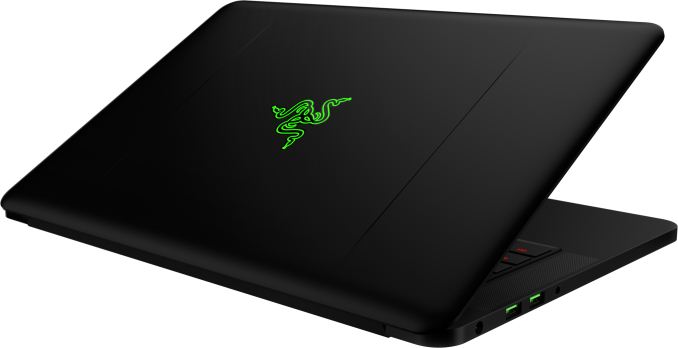
Apart from the CPU and DRAM upgrades, Razer changed display options for the latest breed of Blade laptops. Last year the company only offered its Blades with touch-enabled IGZO LCDs featuring 3200×1800 resolution, and a matte 1920x1080 on the entry level. This year the higher-end Blade machines will feature touch-enabled UHD displays (3840×2160). Usage of the lower-resolution panel allowed Razer to reduce the price of the entry-level Blade to $1899 (or by $100), but at present we do not know how much the 4K SKUs is going to cost. In any case, systems featuring FHD panels will be slightly lighter and will have a longer battery life than models with UHD monitors. We haven't heard back from Razer on if the new UHD display continues to be a Sharp IGZO panel or not. Apart from displays, different Blade systems will look and feel exactly the same: both use a solid CNC-milled aluminum chassis with a matte black finish.
As for the rest I/O capabilities, they remained very similar to those of the last year’s Razer Blade models (because the chassis and the motherboard are the same as those used on the late 2016 Blade): Rivet Networks' Killer 1535 802.11 2×2 Wi-Fi + BT 4.1 controller, one Thunderbolt 3/USB 3.1 Type-C port, three USB 3.0 headers, an HDMI 2.0b output, a 2 MP webcam, built-in speakers and a microphone, a TRRS audio connector, a keyboard with RGB backlighting and so on. In a bid to appeal to those who care about security, there is a TPM 2.0 security chip installed.Razer Blade Comparison 2017 Razer Blade FHD 2017 Razer Blade UHD Late 2016 Razer Blade CPU Intel Core i7-7700HQ
4C/8T
2.8 GHz/3.8 GHz
6 MB
45 WIntel Core i7-6700HQ
4C/8T
2.6/3.5 GHz
6 MB
47WGPU NVIDIA GTX 1060 6 GB Memory 16 GB DDR4-2400 16 GB DDR4-2133 Display 1920×1080 matte 3840×2160 touch 3200×1800 IGZO touch Storage 256/512/1024 GB PCIe M.2 256/512 GB PCIe M.2 I/O 3×USB 3.0
HDMI 2.0b
Thunderbolt 3/USB-CWireless Killer Wireless-AC 1535 Dimensions 13.6" × 9.3 " × 0.70"
345 mm × 235 mm × 17.8 mmWeight 1.86 kg
4.1 lbs1.95 kg
4.3 lbs1.93 kg
4.25 lbsBattery 70 Wh Keyboard Razer Chroma anti-ghosting Price $1899 unknown $1999-$2199
The new Razer Blade notebooks with FHD screens are available now in North America and Europe starting from US$1,899/C$2,749/€2.149/£1.799. The laptops with 4K UHD panels will be available in Q2 and Razer does not have pricing available at the moment, but expect it to be similarly priced to the outgoing QHD+ model.
Gallery: Razer Blade Early 2017





Related Reading:
- Razer Unveils The Updated Razer Blade: Chroma Keyboard, Skylake, And A Lower Price
- Razer Updates The Razer Blade And Razer Blade Stealth At PAX
- Razer Re-Launches The Razer Blade Pro: GTX 1080 And 4K G-SYNC
- The Razer Blade Stealth Review: Razer Takes On The Ultrabook
More...
-
02-15-17, 06:33 AM #6727
Anandtech: NVIDIA Releases 378.66 WHQL Driver: Game Ready, More Ansel, With 10 and 12
Not wanting to be left out of the Valentine’s day fray, NVIDIA has swung by to drop off their driver updates in preparation for this week’s releases and next week’s release of Halo Wars 2. Cyber photographers can itch their shutter finger with new game support for Ansel, and we’ve been given more high bit depth video support.
As the 378.66 driver update continues with release branch 378 we see the list of fixes start with an issue keeping surround from being enabled on an XGPU. When G-Sync and V-Sync are both enabled, there was a long delay while switching between windowed and full-screen modes. Players of Second Life will no longer experience a blue tinted world after disabling advanced lighting, and The Division no longer shows shadow flicker after enabling PCSS. On Kepler GPU’s in Battlefield 1 NVIDIA has fixed in game flickering when using TAA and menu text no longer jitters for the Battlefield Day 28 Patch when SLI is enabled. Users playing on SLI GTX 1080’s with surround on HDMI 2.0 should have less system crashes while launching games now, and Heroes of the Storm should be done crashing on startup as well. Also, GeForce 860M Notebooks are no longer causing Direct X games to crash. Finishing up the fixes, we have a Minecraft Java SE Binary crash that was pointing to nvinitx.dll, and a fix for the GTX 980 Ti struggling to detect multiple TV models.
Alongside this release, NVIDIA has added Video SDK 8.0. This finally exposes high-bit-depth (10/12-bit) decoding for VP9 and HEVC to projects using NVIDIA's specialized NVDEC video decoder. Video SDK 8.0 also adds support for OpenGL input surfaces for encoders, weighted prediction, and H.264 ME-only mode enhancements. NVIDIA is also providing Game Ready support for Sniper Elite 4, For Honor and Halo Wars 2. For Honor and Paragon both now have Ansel support and additionally, NVIDIA recommends those interested in playing For Honor do so with a GTX 1060 at 1080p, a GTX 1070 at 1440p, and 1070 SLI for 4K for an excellent high quality experience.
Anyone interested can download the updated drivers through GeForce Experience or on the NVIDIA driver download page. More information on this update and further issues can be found in the 378.66 release notes.
More...
-
02-15-17, 08:30 AM #6728
Anandtech: Toshiba Announces MN-Series HDDs: Up to 8 TB
Toshiba has announced a new family of 3.5" hard drives for home and SOHO NAS devices. The new MN-series HDDs have up to 8 TB of capacity and support some of the features found in Toshiba’s enterprise-class hard drives. The performance of the new HDDs is similar to the performance of high-end hard drives from other makers, all due to increased areal density.
The Toshiba MN-series family includes 4 TB, 6 TB and 8 TB models with a SATA 6 Gb/s interface (note that the higher-end model supports the SATA 3.3, whereas the others are compliant with the SATA 3.1). The HDDs feature 7200 RPM spindle speed, are equipped with 128 MB buffers, and use rotational vibration (RV) sensors that detect and compensate for transient vibrations in multi-bay NAS and server environments - this aims to ensure that the drives deliver consistent performance. Speaking of performance, Toshiba declares up to 230 MB/s sustained data transfer rate as well as 4.17 ms average latency time for the top-of-the-line 8 TB model.
The new drives are based on several PMR platters (perpendicular magnetic recording) but are not filled with helium. (Helium can be used to increase the number of disks per drive beyond six). The Toshiba MN05ACA800 therefore uses six 1.33 TB platters, and the other drives use either fewer platters or ones with a lower capacity (as well as lower areal density).
The MN-series HDDs from Toshiba are rated for 24/7 availability, with 1 million hours MTBF as well as a 180 TB/year workload rating. While the MTBF and the annual workload ratings are considerably lower when compared to enterprise-class hard drives, the MN-series still offer higher endurance compared to regular desktop HDDs.Toshiba MN-Series HDDs MN05ACA800 MN05ACA600 MN04ACA400 Capacity 8 TB 6 TB 4 TB RPM 7200 RPM Interface SATA 3.3 6 Gbps SATA 3.1 6 Gbps DRAM Cache 128 MB Data Transfer Speed
(Sustained)230 MB/s 205 to 230 MB/s 195 to 205 MB/s MTBF 1 million hours Rated Workload (Drive Writes Per Day) 0.061 0.082 0.123 180 TB/year Acoustics (Seek) 33 dB 30 dB Power Operating 9.2 W 10.1 W 9.6 W Active Idle 6.2 W 6.7 W 5.2 W Warranty unknown
The Toshiba MN-series HDDs will be available in the coming weeks and months, but the manufacturer has not published its recommended prices just yet.
Related Reading:
- Seagate Confirms Plans for 12 TB HDD in Near Future, 16 TB HDD Due in 2018
- Western Digital Announces Ultrastar He12 12 TB and 14 TB HDDs
- Promise Launches Pegasus3 External Storage via TB3: Up to 48 TB, 1.6 GBps
- Toshiba Announces Plan to Sell Minority Stake In NAND Flash Production Business
More...
-
02-15-17, 08:30 AM #6729
Anandtech: The BitFenix Whisper M 450W & 850W PSU Review
BitFenix recently released a new PSU series, the Whisper M, which is aimed towards advanced users that want a product balanced between price and performance. The series consists of five units, ranging from 450W to 850W. We are having a look at the alpha and the omega units of the series in this review.
More...
-
02-15-17, 10:13 AM #6730
Anandtech: EVGA's New iCX Range: NVIDIA GPUs with More Control for Cooling
EVGA has introduced a new iCX cooling and tuning technology for its GPUs that promises higher efficiency and better control compared to predecessors. The video cards feature multiple onboard thermal sensors and microcontrollers (MCUs) designed that enable users to precisely tune settings of their cards and monitor their state for potentially better performance, stability, and endurance.
Modern high-end graphics adapters have three heat sources: the GPU silicon itself, the memory chips, and the VRM circuitry. To overclock a video card successfully, one needs to ensure that none of these components overheats under the higher voltage. While modern GPU silicon has built-in temperature sensors, memory chips do not (GDDR5X chips have integrated temperature sensors, rare GDDR5 ICs do too) and VRM temperature cannot be monitored without using special tools as well. Motherboard manufacturers usually add onboard sensors for monitoring, and here EVGA is doing the same. Squeezing all the overclocking headroom from a graphics card may be complicated since it is not easy to determine which component is overheating due to the high load, and a typical response is to increase cooling to the whole card (which means increasing the speed of all the fans creating excessive noise). EVGA's new cooler design is meant to offer more control over what needs to be cooled.
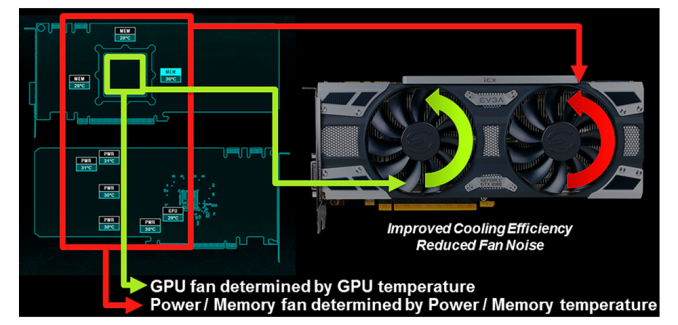
EVGA’s iCX technology uses nine thermal sensors on the graphics card to monitor GPU, VRM and memory temperatures and then its Precision XOC software can make decisions regarding cooling the components that actually require it. In a bid to cool-down VRM, the application increases the speed of the fan on the right-hand-side of the card, whereas when the GPU and memory need some extra cooling, the board speeds up the left fan. Fan speeds are regulated independently with their own temperature/power curves and therefore do not produce excessive noise unless needed. Alternatively, users can manually regulate GPU and memory frequencies as well as fan speeds using the Precision XOC software, and the fans will react accordingly. The app allows to set power and temperature targets and even create profiles for different occasions.
In addition to the new PCB design and the Precision XOC software, the iCX package includes a new cooling system with redesigned heatsinks (which EVGA calls “purposefully-directed airflow chambers”). The latter now have small holes in their fins to make it easier for the air to pass through them. The heatsink fins are L-shaped to increase surface contact, and some fins are half open to maximize airflow. Finally, the cooler has a special thermal LED display system that reflects a combination value of the temperature of the GPU, memory and VRM, and can act as a visual aid to warn users of overheating (if the software does not do it for some reason).
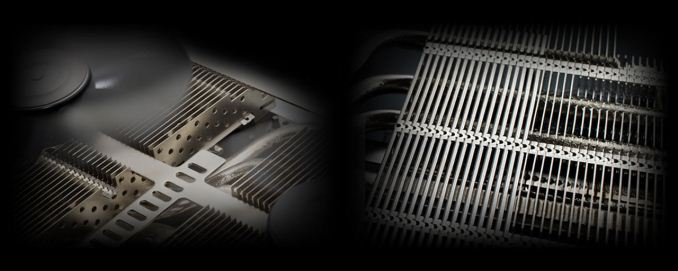
EVGA will use its iCX cooling initially on variants of NVIDIA cards that feature its proprietary PCBs (e.g., FTW2, SC2, etc.), just like it uses the ACX-series coolers today. The initial family (see the tables for details) of add-in-boards with iCX includes three GTX 1080 parts, three GTX 1070 parts, and four GTX 1060 6GB/3GB cards.
As usual, some of EVGA’s AIBs come factory overclocked and may have an increased TDP when compared to NVIDIA's reference designs. Due to different frequencies and TDPs, all the cards have different PCB designs and different VRMs, but the key components of the iCX (sensors, MCUs, two fans, safety fuse, etc.) are present on all iCX cards.EVGA GeForce GTX 1080 with iCX Technology GTX 1080 GAMING iCX GTX 1080 SC2 GAMING iCX GTX 1080 FTW2 GAMING iCX 08G-P4-6581-KR 08G-P4-6583-KR 08G-P4-6686-KR Stream Processors 2560 Texture Units 160 ROPs 64 Core Clock (MHz) 1607 1708 1721 Boost Clock (MHz) 1733 1847 1860 Memory Capacity 8 GB Type GDDR5X Clock 10 Gbps TDP 180 W 180 W 215 W Launch Date Q1 2017 Launch Price $639.99 $649.99 $679.99
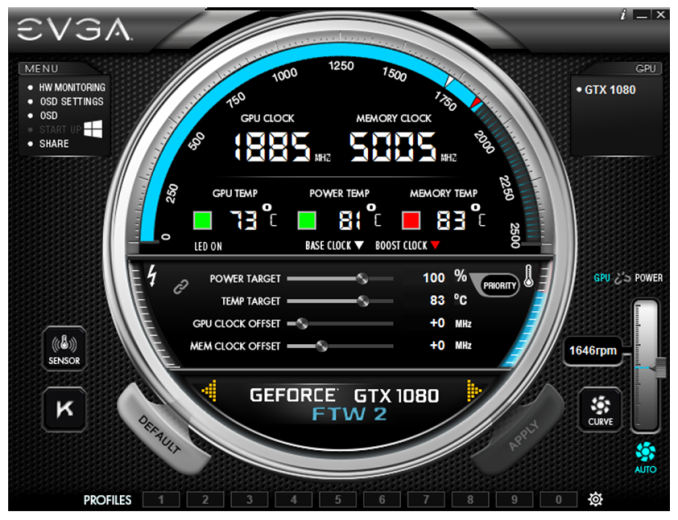
EVGA currently sells two graphics cards with its iCX cooling and tuning technology: the EVGA GeForce GTX
1080 SC2 GAMING iCX ($649.99) and the EVGA GeForce GTX 1070 SC2 GAMING iCX ($449.99). Those interested in other members of the new lineup may sign up for notification about their availability. Given that EVGA has already announced all the cards, they should hit the market in the coming weeks, but we are not sure whether all the remaining SKUs are going to arrive at the same time.
As for pricing, the addition EVGA’s iCX cooling will come at a small premium. The cheapest EVGA GeForce GTX 1080 with iCX will be priced at $639.99 ($40 above NVIDIA’s MSRP), whereas the lowest-cost EVGA GeForce GTX 1070 with iCX will be sold for $439.99 ($60 above MSRP). Prices for EVGA’s GeForce GTX 1060 boards with iCX were given at this time.EVGA GeForce GTX 1070 with iCX Technology GTX 1070 GAMING iCX GTX 1070 SC2 GAMING iCX GTX 1070 FTW2 GAMING iCX 08G-P4-6571-KR 08G-P4-6573-KR 08G-P4-6676-KR Stream Processors 1920 Texture Units 120 ROPs 64 Core Clock (MHz) 1506 1594 1607 Boost Clock (MHz) 1683 1784 1797 Memory Capacity 8 GB Type GDDR5 Clock 8 Gbps TDP 150 W 170 W 215 W Launch Date Q1 2017 Launch Price $439.99 $449.99 $469.99
Related Reading:EVGA GeForce GTX 1060 with iCX Technology GTX 1060
6GB SSC2 GAMING iCXGTX 1060
6GB FTW2+ GAMING iCXGTX 1060
3GB SSC2 GAMING iCXGTX 1060
3GB FTW2+ GAMING iCX06G-P4-6667-KR 06G-P4-6768-KR 03G-P4-6567-KR 03G-P4-6767-KR Stream Processors 1280 1152 Texture Units 80 72 ROPs 48 Core Clock (MHz) 1607 1632 1607 1632 Boost Clock (MHz) 1835 1860 1835 1860 Memory Capacity 6 GB 3 GB Type GDDR5 Clock 8 Gbps TDP 120 W 150 W Launch Date 1H 2017 Launch Price TBD TBD TBD TBD
- Zotac and EVGA Reveal Custom GeForce GTX 1080 Designs
- EVGA Rolls Out SC17: High-End Gaming Laptop Designed for Overclocking
- EVGA Begins Selling "VR Edition" GeForce GTX Video Cards for VR Gaming Rigs
More...
Thread Information
Users Browsing this Thread
There are currently 19 users browsing this thread. (0 members and 19 guests)




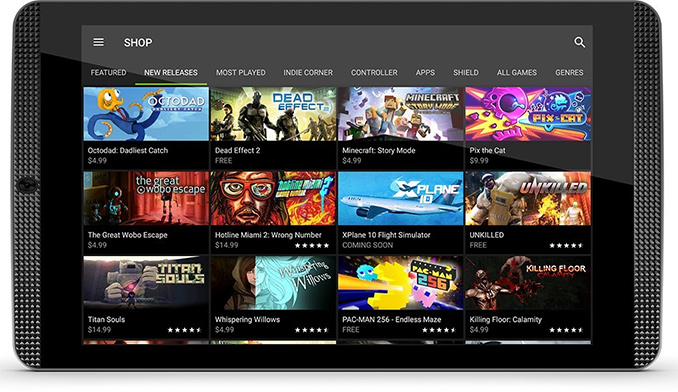

 Quote
Quote
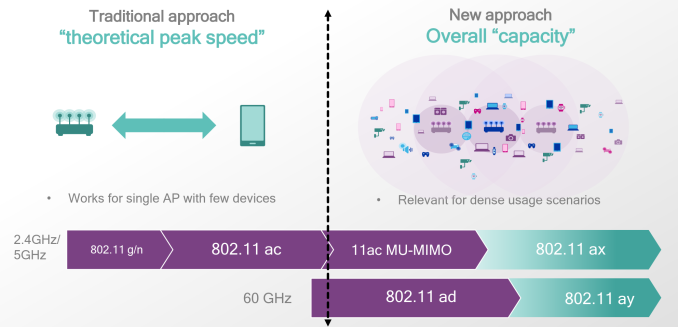
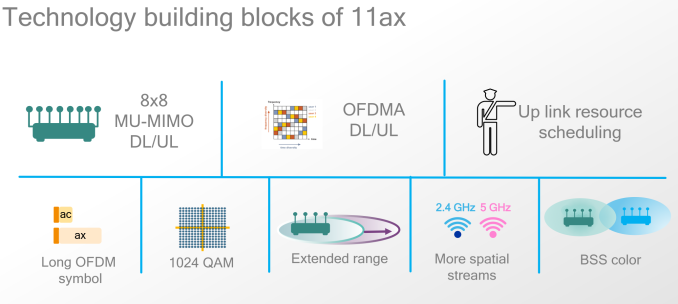
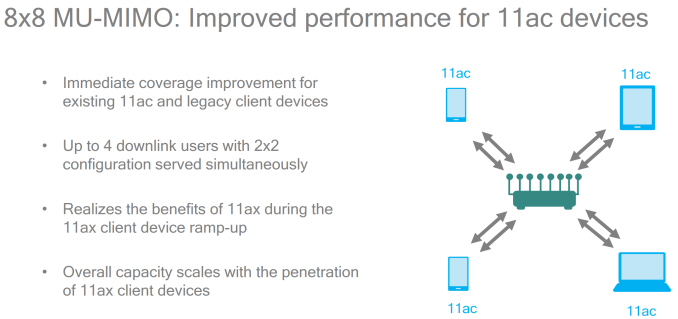
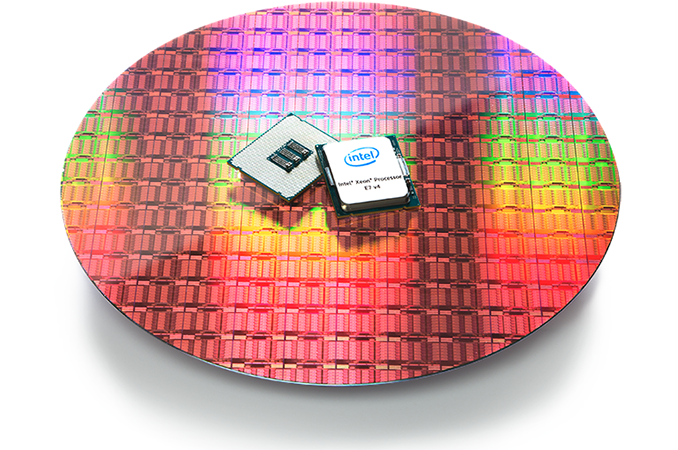
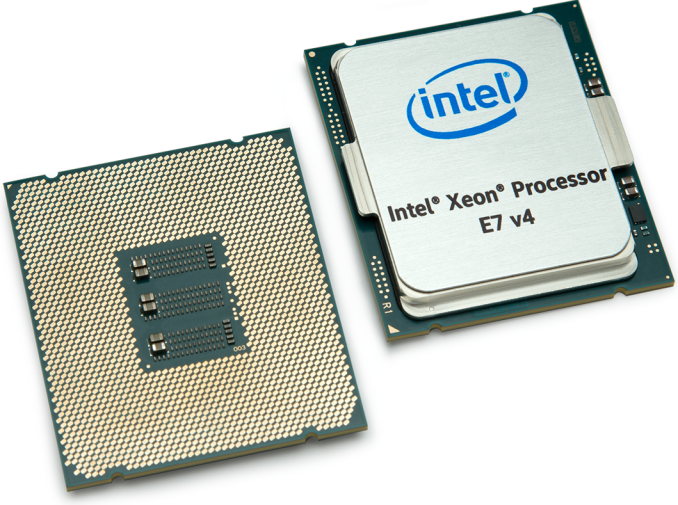
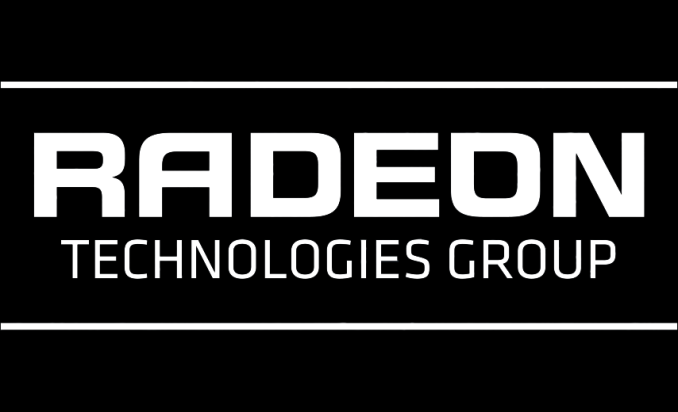
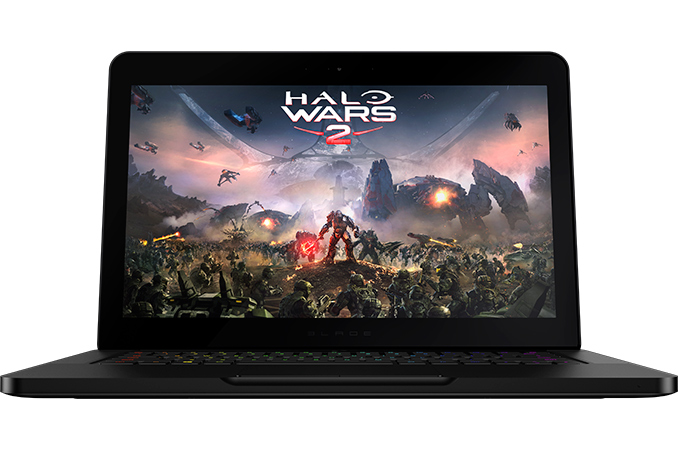
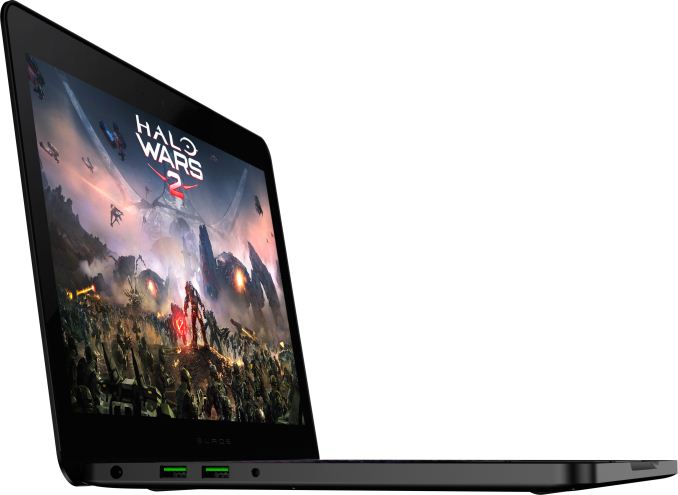
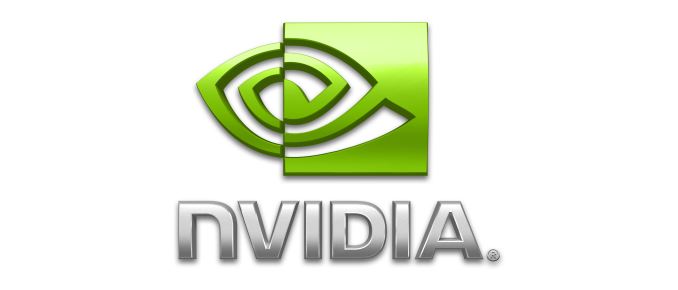




















Bookmarks